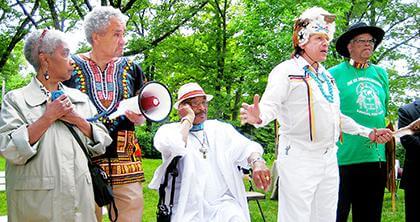By Anna Gustafson
Decades after the city built a playground on top of the 19th-century graves of African and native Americans in Flushing, residents said honor has finally begun to be restored to the individuals whose burials were marred by discrimination.
Elected officials and residents gathered Sunday to celebrate the renaming of Martins Field, which is now known as the Olde Towne of Flushing Burial Ground.
“We have reclaimed this as a place with real history,” city Comptroller John Liu said. “Today the new name recognizes the history that is beneath us.”
Members of the Olde Towne of Flushing Burial Ground Conservancy, led by Bayside resident Mandingo Tshaka and aided by Liu, began working years ago to move a playground from the cemetery between 164th and 165th streets along 46th Avenue. The playground was ultimately moved to the northern section of the site, where officials said there are no graves below.
More than 1,000 people, many of them minorities, were buried in the graveyard between 1840 and 1898. The city would not allow many minorities to be buried within city limits, which is why many blacks and native Americans were buried at the site, Tshaka said. Poor whites, as well as wealthier individuals who died during a series of cholera and smallpox epidemics in the mid-1800s, were also interred there.
The site, which had been purchased by what was the town of Flushing in 1840, was given to the city Parks Department in 1914. In 1931, the area was renamed Martins Field in honor of tree conservationist Everett Martin, who conservancy members said had no known connection to the cemetery’s history.
A playground was built on the site in 1936 as part of the federal Works Progress Administration, during which time conservancy members said the four headstones at the site were removed. Three of those markers were for members of the Bunn family, whose relative was at the renaming ceremony last weekend.
“The main thing I hope comes out of this is we recognize people as people,” said Jay Williams, a relative of the Bunns. “Everybody made contributions to this city and it’s time to forget the color of people’s skin and remember what they accomplished.”
Members of the Bunn family worked with the Parsons, one of Flushing’s best-known families who ran nurseries, to train horses, Williams said.
Tshaka and others at the renaming ceremony said they want the city to put in headstones visible to individuals driving or walking by so they can recognize the area is a cemetery.
“Thank God we’ve been able to get the name changed,” Tshaka said. “The burial grounds of people with African ancestry have been turned into parks and that’s a disgrace. It’s disrespect. It’s a deliberate eradication of a people’s history.”
City Councilman Peter Koo (R-Flushing) said he was pleased the city was recognizing the graves that for too long went unnoticed.
“We must always remember to respect the individuals who made this their final resting place,” Koo said.
State Assemblyman Rory Lancman (D-Fresh Meadows), Councilman Dan Halloran (R-Whitestone) and Chief Little Fox of the Sachem Matinnecock Nation were also present at the renaming ceremony.
Reach reporter Anna Gustafson by e-mail at agustafson@cnglocal.com or by phone at 718-260-4574.


































